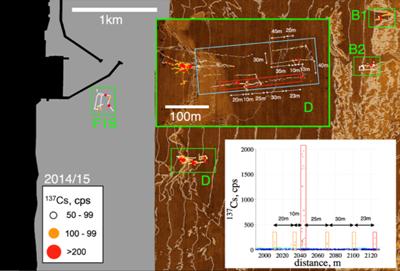Subsea robotic mapping and recovery of radioactive particles from the Fukushima Daiichi Nuclear Plant

An article recently published by University of Southampton SMMI academic, Prof. Blair Thornton (Maritime Engineering group; Co-director of the In Situ and Remote Intelligent Sensing (IRIS) Faculty of Engineering and Physical Science Centre of Excellence), describes the development of a robotic submersible that was used to map and recover high-concentration radio cesium enriched particles that had been released from the Fukushima Daiichi Nuclear Plant as a result of the 2011 Great Eastern Earthquake, Tsunami and nuclear disaster [1].

A total of 37 point sources were discovered, and five particles were recovered for detailed analysis
The camera equipped robotic submersible developed by Prof Thornton and his team to recover these particles was instrumented with an in situ radiation spectrometer that allows the location of underwater radioactive particles to be pinpointed, and used to trigger a suction sampling device mounted on the robot that recovers these for detailed laboratory analysis.
A total of thirty-seven radio Cesium enriched particles were mapped within a few kilometres of the nuclear plant, five of which were recovered and analysed to determine their nature and origin.
The project as driven by previous finding of Prof. Thornton and his team, who deployed a towed gamma-ray scintillation spectrometer (described in [2]) to map the fine-scale distribution of radioactive material in marine sediments within a 25 km radius of the Fukushima Daiichi Nuclear Plant.

Scanning electron microscope images of the recovered radio cesium enriched particles and typical sediments (bottom right) for comparison. The radio cesium enriched particles were <400 micrometres in diameter and had a variety of particle matrices. The only significant radioactive peaks detected were of radio-cesium, and no trace of heavier radio isotopes derived from nuclear fuel (i.e. uranium, plutonium) were detected from the particles
“Our towed seabed spectrometer surveys in 2012 and 2013 discovered anomalies in the radio cesium concentration of seabed sediments near the destroyed nuclear plant. The distribution of these anomalies was strongly correlated to the shape of the underwater terrain, forming high concentration patches several tens to hundreds of metres across. These exist at the bases of cliffs and valleys, where fine sediments can settle and remain undisturbed by underwater currents.”
He continues, “In parallel to these, we found evidence of radio cesium point sources that were sparsely distributed on the seafloor, separated by several tens of metres in regions with the most dense distribution near plant. Their distribution had no correlation with shape of the underwater terrain.”
Targeted collection of individual particles that are sparsely distributed on the seafloor like this is not possible without realtime feedback from radiation sensors. Furthermore, the only way to safely recover particles with pinpoint accuracy is through the use of robotic submersibles.
“The robotic system we developed was deployed several times in the regions based on our prior towed seabed radiation surveys. The robot was equipped with the same gamma-ray scintillation spectrometer we developed for the towed surveys, and we found 37 of these particles on the seafloor. Five of these were recovered for detailed laboratory analysis.
Each particle was less than 400 micrometers in diameter, and It would not have been possible to recover these without the precise in situ detection and sampling technology we developed”.
Analysis of different radio-isotopes in the recovered paricles confirmed that these originated during the 2011 nuclear disaster. The particles were analysed using a high-purity germanium detector, which showed that the only significant radioactive peaks were those of radio-cesium, and no traces of heavier isotopes derived from nuclear fuel (i.e. uranium, plutonium) was found.
Detailed Scanning electron microscope measurements and chemical analysis using X-ray spectrometry revealed that some of these particles contained calcium and titanium, while others consisted of aggregates or sediments.
Prof. Thornton states, “It is important to understand the origin and nature of these. The technology we developed has given us a pathway to achieve this. From what we have found so far, these particles form a very small fraction of the total amount of radio-cesium released during the Fukushima nuclear disaster.
The distribution of cesium enriched particles is limited to the vicinity of the plant, with most of the particles found within a few kilometres of the accident site. The cesium particles we found are insoluble, which means that they would be excreted if incorporated into the body of an organism.
The strong radiation shielding effect of water means that external exposure to radiation from these particles is not expected past a few tens of centimetres. It is crucial that we understand more about the distribution of these particles, and also document the technology and method that are effective to detect and recover these from the ocean in case of any future nuclear accidents.”
This work was funded by the Japan Science and Technology Agency SENTAN (Frontier) program and the Nuclear Regulation Authority of Japan. The article described can be accessed at the following link:
https://www.tandfonline.com/doi/abs/10.1080/00223131.2021.1879688
References
[1] Seiki Ohnishi , Blair Thornton , Toshikazu Koike , Naoteru Odano, Mitsufumi Asami , So Kamada , Kazunori Nagano & Tamaki Ura (2021): Analysis of radioactive cesium-enriched particles and measurement of their distribution in marine sediment near Fukushima Daiichi nuclear power plant, Journal of Nuclear Science and Technology, DOI:10.1080/00223131.2021.1879688
[2] Blair Thornton, Seiki Ohnishi, Tamaki Ura, et al (2013): Distribution of local 137Cs anomalies on the seafloor near the Fukushima Dai-ichi nuclear power plant. Mar Pollut Bull. 74(1) 344–350